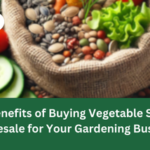Imagine a garden bursting with vibrant flowers, thriving vegetables, and lush greenery—all rooted in nutrient-rich soil. The secret? Compost.
How Much Compost Is Needed for a Garden? Whether you’re starting a new garden bed, revitalizing tired soil, or enhancing a container garden, knowing the right amount of compost to use can make all the difference.
Too little, and your plants may struggle to grow; too much, and you risk overwhelming the soil.
In this guide, we’ll break down how to calculate the perfect amount of compost for your gardening needs, explore the incredible benefits of compost, and share expert tips on application techniques to ensure your plants get the nourishment they need to flourish. Let’s dig in!
How Much Compost Do I Need for My Garden?
How to Calculate How Much Compost You Need
To calculate how much compost you need for your garden, you first need to determine the area you plan to cover and the desired depth of compost.
A common recommendation is to apply 2 to 3 inches of compost. To figure out how much compost you need, multiply the area of your garden beds in square feet by the depth of compost in inches, then divide by 12 to convert to cubic feet.
This calculation will give you the volume in cubic feet. If you need it in cubic yards, simply divide by 27. Using a compost calculator can simplify this process, providing accurate measurements with ease.
It’s essential to consider the existing soil conditions and the specific needs of your plants when calculating how much compost to add.
You may need more compost if your native soil is particularly poor or depleted.
Additionally, if you’re working with raised beds, ensure you account for the dimensions accurately. Remember that the compost depth can influence water retention and nutrient availability, so measuring carefully is crucial.
This comprehensive approach will help you determine the appropriate amount of compost needed to enrich your garden effectively.
What is the Right Amount of Compost for Garden Beds?
The right amount of compost for garden beds typically ranges from 2 to 4 inches, depending on the type of plants you are cultivating and the quality of your existing soil.
For instance, if your garden beds consist of native soil that is compacted or low in nutrients, adding a thicker layer may be necessary to improve fertility and structure.
However, if your garden beds are already well-maintained, a layer of 2 inches may suffice. Always remember that too much compost can lead to issues such as poor drainage or nutrient imbalances.
When applying compost, it’s also crucial to consider how it will interact with your existing soil.
Compost helps to create a nutrient-rich environment that fosters beneficial microbial activity, which can be particularly advantageous for young plants or new seedlings.
The right amount of compost will also help suppress weeds while retaining moisture, thus improving overall plant health. By carefully assessing your garden’s needs, you can determine the optimal depth of compost to apply, ensuring a thriving garden ecosystem.
Using a Compost Calculator for Accurate Measurements
A compost calculator is a valuable resource for gardeners looking to determine the precise amount of compost required for their projects.
By inputting essential details such as the area of your garden beds and desired compost depth, a compost calculator can quickly compute the necessary volume in cubic feet or cubic yards.
This tool is especially beneficial for those unfamiliar with manual calculations, as it reduces the possibility of error and ensures that you apply the right amount of compost.
Moreover, many compost calculators are readily available online and are user-friendly, making them accessible for both novice and experienced gardeners.
They often include options for different garden types, such as raised beds or in-ground gardens, further tailoring the results to your specific needs.
By utilizing a compost calculator, you can confidently move forward with your gardening plans, ensuring that your plants receive the proper nutrition and support for optimal growth and development.
Understanding the Role of Compost in Soil Health
How Does Compost Improve Soil Quality?
Compost plays a vital role in enhancing soil quality by adding organic matter, which improves soil structure and aeration.
This organic matter not only retains moisture but also promotes healthy microbial activity, essential for nutrient cycling.
When compost is mixed into the soil, it increases the soil’s ability to hold nutrients and water, which is especially important during dry periods.
Additionally, compost helps to buffer the soil pH, creating a more favorable environment for plant roots to thrive.
Another significant benefit of compost is its ability to suppress soil-borne diseases and pests.
By fostering a diverse microbial community, compost can outcompete harmful pathogens, leading to healthier plants.
It also adds essential nutrients such as nitrogen, phosphorus, and potassium, which are crucial for plant growth.
Thus, incorporating compost not only improves the physical properties of soil but also enhances its chemical and biological characteristics, resulting in a robust and productive garden.
What are the Benefits of Adding Compost to Existing Soil?
Adding compost to existing soil provides numerous benefits that significantly contribute to plant health and productivity.
One of the primary advantages is the enhancement of nutrient content; compost enriches the soil with essential elements that support plant growth.
This nutrient boost can lead to stronger plants, which are more resilient against diseases and pests.
Moreover, compost improves the soil’s moisture retention capabilities, reducing the need for frequent watering and promoting sustainable gardening practices.
Furthermore, compost acts as a natural fertilizer, slowly releasing nutrients over time, which minimizes the risk of nutrient leaching and runoff into waterways.
This slow-release characteristic makes compost an eco-friendly alternative to chemical fertilizers, promoting environmental health.
The addition of compost also encourages beneficial earthworms and microorganisms, which aerate the soil and help break down organic matter further, enhancing soil fertility. Ultimately, adding compost creates a thriving ecosystem that benefits not just the plants but the entire garden environment.
Compost Application Techniques for Gardens
How to Properly Add Compost into the Soil
To properly add compost into the soil, it is essential to follow a systematic approach for optimal results.
Begin by removing any weeds or debris from the area where you intend to apply the compost.
Once the area is clear, you can spread a layer of compost evenly over the soil surface, aiming for a depth of 2 to 4 inches.
After applying the compost, use a garden fork or tiller to mix it thoroughly into the soil. This ensures that the compost integrates well and allows for better nutrient distribution.
It’s also advisable to work the compost into the top 6 to 8 inches of soil, as this is where most plant roots will be growing.
If you’re working in raised beds, ensure that you distribute the compost evenly throughout the bed, as this will promote uniform plant growth.
Moreover, consider the timing of your compost application; adding compost in the fall can benefit winter crops, while spring applications are advantageous for summer gardens.
What is the Best Way to Layer Compost in Raised Beds?
Layering compost in raised beds is an effective method to optimize soil health and support plant growth.
The best approach is to create a layered system that combines compost with other organic materials, such as straw, leaves, or garden clippings.
Begin by placing a layer of coarse materials at the bottom of your raised bed; this layer aids in drainage and aeration.
Next, add a layer of compost, followed by a layer of native soil or topsoil. This combination creates a diverse environment that benefits plants.
When layering, aim for a total compost depth of 2 to 4 inches, ensuring that it is well-distributed throughout the bed.
It’s essential to maintain a balance between the compost and other organic materials to prevent compaction and to promote microbial activity.
Regularly monitor the moisture levels in the raised bed, as compost will help retain moisture, but additional watering may be necessary during dry spells.
Proper layering techniques not only enhance soil structure but also contribute to a thriving ecosystem within your raised beds.
How to Rake and Aerate Soil Before Compost Application
Raking and aerating the soil before compost application is a crucial step in preparing your garden for optimal growth.
Begin by using a rake to level the soil surface and remove any rocks, debris, or weeds that may hinder plant growth. Raking also helps to break up any compacted areas, allowing for better water infiltration and root penetration.
This initial step ensures that the compost will mix easily with the soil, promoting effective nutrient distribution.
After raking, it’s advisable to aerate the soil using a garden fork or aerator tool. Aeration creates small holes in the soil, allowing air and moisture to penetrate more deeply.
This process is particularly beneficial in compacted soils, as it enhances root development and encourages microbial activity.
Once the soil is adequately raked and aerated, you can proceed to apply your compost. This preparation ensures that your plants will have access to the nutrients and moisture they need for healthy growth and development.
Using Compost in Different Types of Gardens
How Much Compost is Needed for a New Lawn?
When establishing a new lawn, the amount of compost needed can vary depending on the soil type and the desired lawn thickness.
Generally, a layer of 1 to 2 inches of compost is recommended for new lawns. This layer should be applied after the soil has been prepared, ensuring that it is free of weeds and debris.
The compost will not only enrich the soil but also provide essential nutrients that support grass seed germination and growth.
For best results, mix the compost into the top 6 to 8 inches of soil to create a fertile environment for the grassroots.
If the existing soil is poorly drained or low in nutrients, consider increasing the compost layer to 2 inches.
Additionally, using a compost calculator can help you determine the precise amount of compost needed, based on the area of your lawn. Incorporating compost into your new lawn establishment can help you lay the foundation for a lush and healthy yard.
Do I Use Compost for Potting Soil?
Yes, compost is an excellent addition to potting soil, enriching it with essential nutrients and organic matter.
When creating potting mixes, it’s advisable to combine compost with other components such as peat moss and perlite or vermiculite.
This mixture provides the necessary drainage and aeration that potted plants require while ensuring they receive the nutrients they need for healthy growth.
Typically, a ratio of 1 part compost to 2 parts potting mix works well.
Using compost in potting soil not only reduces the need for synthetic fertilizers but also enhances the microbial activity within the pot, promoting a healthy root system.
Additionally, compost retains moisture effectively, which is beneficial for container gardening, as it reduces the frequency of watering.
Remember to monitor the moisture levels in your containers, as potted plants can dry out more quickly than those in the ground.
Overall, incorporating compost into potting soil fosters robust plant health and growth.
Can I Use Compost as Mulch in My Garden?
Compost can indeed be used as mulch in your garden, offering multiple benefits to your plants and soil. When applied as a top layer, compost mulch helps to suppress weeds, retain moisture, and regulate soil temperature.
A layer of about 1 to 2 inches is typically recommended, as it allows for proper aeration while still providing the necessary coverage.
This application not only enhances the appearance of your garden but also contributes to the overall health of your soil.
Using compost as mulch also introduces beneficial microorganisms to the soil surface, promoting nutrient cycling and improving soil fertility over time.
As the compost breaks down, it releases nutrients that plants can readily absorb, providing an organic alternative to synthetic fertilizers.
Additionally, compost mulch can reduce soil erosion, protecting the integrity of your garden beds. Incorporating compost as mulch can help you create a sustainable solution that benefits both plants and the environment.
Conclusion
Compost is a powerful tool for enriching soil, promoting healthy plant growth, and creating a thriving garden ecosystem.
By understanding how much compost your garden needs and applying it correctly, you can maximize its benefits while avoiding potential issues like nutrient imbalances or poor drainage.
Compost is essential for maintaining healthy and sustainable soil, whether you’re starting a new lawn, enriching garden beds, or enhancing potting soil.
With proper calculations, strategic application techniques, and the right composting methods, you can transform your garden into a flourishing, nutrient-rich space.
So, grab your compost, follow these expert tips, and watch your plants thrive!
Happy gardening!




